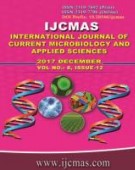


 National Academy of Agricultural Sciences (NAAS)
National Academy of Agricultural Sciences (NAAS)

|
PRINT ISSN : 2319-7692
Online ISSN : 2319-7706 Issues : 12 per year Publisher : Excellent Publishers Email : editorijcmas@gmail.com / submit@ijcmas.com Editor-in-chief: Dr.M.Prakash Index Copernicus ICV 2018: 95.39 NAAS RATING 2020: 5.38 |
A major problem in MRSA-infected patients is the co-infection with Gram-negative bacteria which are naturally resistant to Vancomycin (VA) and linezolide (LZD). In the past; the use of a combination of VA and ß-lactam antibiotics was one of the solutions for treating of such condition depending on synergism. In the recent years; a class of MRSA that becomes resistant to VA only in the presence of ß-lactam antibiotics (BIVR) has been emerged meaning that there is antagonism. This type of VA resistance is mainly due to stimulation of peptidoglycan metabolism and repair system, by ß-lactams, so rapidly depleting free VA to a level below its MIC. This means that ß-lactams should remain intact in BIVR culture, although most MRSA cells are known to produce ß-lactamase, meaning that the BIVRs either did not carry the ß-lactamase gene (blaZ) or this gene was suppressed. The present study aimed for screening for the tendency of VA sensitive MRSA to become VA resistant when exposed to β-lactams in vitro; as a result, MRSA possessing the capability to become BIVR in vivo can expected. Also, investigating the relation between the ×´ BIVR phenomenon×´ and the ß-lactamase activity. We studied 130 MRSA isolates, identified by the disc diffusion method and MecA gene amplification PCR. The isolates were selected to be VA susceptible with MIC ≤2 μg/mL. The isolates were subjected to the BIVR screening test, testing the ß-lactamase activity and conducting PCR amplification of blaZ gene. BIVR testing of the MRSA strains revealed that 13.8% of the MRSA strains were BIVR positive while 86.2 % were BIVR negative. All the BIVRs showed an undetectable ß-lactamase activity by nitrocefin test, most of them (83.3%) lacked the blaZ gene and the remaining (16.7%) carried the blaZ gene but showed an undetectable ß-lactamase either by nitrocefin test or spectro photometrically, indicating that this gene was down regulated or suppressed in them by certain mechanism. Most (94.6%) non-BIVRs carried the blaZ gene and most of them (79.2%) actively produced detectable ß-lactamase by nitrocefin test. BIVRs gain vancomycin resistance only in presence of ß-lactam antibiotics, so preserving ß-lactams in milieu, by preventing ß-lactamase production, either by lacking or suppressing the blaZ gene.
 |
 |
 |
 |
 |